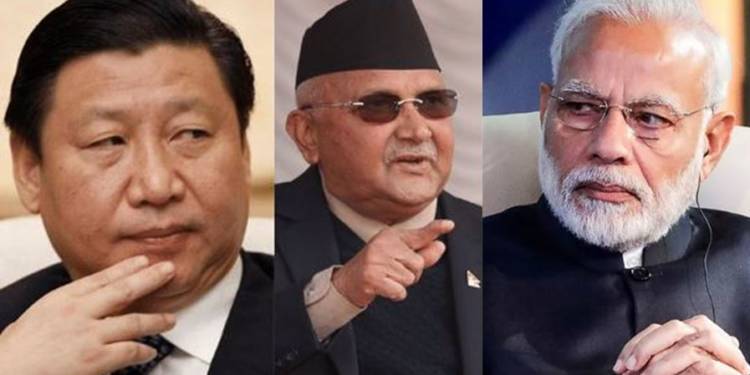The matters are escalating unprecedentedly between India and China. There was a violent face-off and a heavy loss of lives on Monday, so much so that Beijing has hesitated from releasing the number of People’s Liberation Army (PLA) troops who have been slaughtered.
The Monday face-off was an attempt by China to backstab India, which resulted in heavy casualties on China’s side itself and now Beijing understands that it cannot win a straight battle against the Indian Army, so it is looking to open two more fronts against India- Pakistan on India’s West and a Hindu Nepal on India’s North.
Pakistan and China call each other “all-weather friends”, and it is natural that Pakistan is causing more ceasefire violations along the Line of Control (LoC) ever since the Sino-India standoff situation started escalating. India has retaliated disproportionately destroying Pakistan Army posts.
The China-Pakistan axis is one of the contributing factors in the Chinese belligerence on the Line of Actual Control (LAC) in Eastern Ladakh. Last year, India abrogated Article 370 and later a political map was released that reaffirmed India’s legitimate claims on Aksai China patch of Indian territory occupied by China and Gilgit-Baltistan which is under Pakistani occupation.
Beijing has interpreted India’s moves as a threat- it feels that the China-Pakistan Economic Corridor (CPEC), which is a part of Xi Jinping’s flagship Belt and Road Initiative (BRI), could get jeopardised. The infrastructure project that starts in China’s Xinjiang province traverses through Aksai Chin and moves into Gilgit-Baltistan.
China fears losing the occupied territory given India’s growing assertiveness. Therefore, Pakistan has been most probably instructed by Beijing to engage India on the Western front.
Pakistan is virtually a Chinese colony and what has happened is not much of a revelation, the latest Chinese forays have however happened in the Himalayan, landlocked country of Nepal.
The Communist, pro-China political leadership in Nepal is dragging the country into a strategic quagmire by making a blunder at such a crucial juncture. Kathmandu has made a choice, and the choice is not India.
Nepal’s Prime Minister KP Sharma Oli is ratcheting irredentism within the country by bringing up imaginary border disputes against India and supporting the Chinese cause.
The woman pulling the strings in Nepal is the young Chinese Ambassador to Nepal, Hou Yanqi and it is not a matter of surprise that before being made the Chinese envoy to Nepal, she was stationed at the Chinese diplomatic mission in Pakistan.
Hou Yanqi is at the centre of China’s three-front military strategy against India, and she is considered to be one of the most powerful foreign diplomats in the landlocked country.
She has taken control of the Communist Party of Nepal, and sources say that she was a frequent guest at Oli’s residence and office. In fact, a Communist Party of Nepal delegation that was involved in drafting the amended political map showing Indian territories in Nepal was also in touch with the Chinese Ambassador.
She is the one fuelling anti-India sentiment in Nepal, and straining the longstanding Indo-Nepal ties irreparably. Reportedly, the Chinese Embassy also entertained the youth wing of the Communist Party of Nepal, and due to such backdoor efforts, the youth leaders held at the Indo-Nepal border near the Pithoragarh district of Uttarakhand.
The youth leaders also protested in Kathmandu and other Nepalese towns to garner support for raking border disputes with India and souring cultural ties with New Delhi. Through these backdoor tactics, the Chinese Embassy was able to force KP Sharma Oli into fast-tracking the move to amend the Constitution and adopt the amended political map.
According to intelligence reports, Kathmandu was ready to initiate a dialogue with India over the issue. But as tensions soared in the Galwan Valley region, the Communist regime in Nepal also toughened its position- an indication of how Nepal has openly chosen to take Beijing’s side.
By disregarding India’s national security interests, Nepal has backstabbed one billion Hindus in India- a monumental blunder which several upcoming generations in Nepal will regret and will blame KP Sharma Oli-led Communists for souring Indo-Nepal ties.
It isn’t as if New Delhi has not noticed what China is up to- the Indian Army Chief, General M.M. Naravane says that there was never any issue coming from Nepal on the Lipulekh Pass, which is being disputed by Kathmandu ever since India inaugurated the Dharchula-Lipulekh road link.
He said, “There is reason to believe that they (Nepal) might have raised this issue at the behest of someone else and that is very much possibility,” thus hinting at China’s interference in Nepal without naming it.
The External Affairs Minister S. Jaishankar also told his Chinese counterpart, “What happened in Galwan was premeditated and planned action by China which was responsible for the sequence of events.”
India knows what China is up to- it is growing increasingly aware of Beijing’s scheme to encircle India with three fronts in the Himalayas.
Nepal has however done more harm than good by falling for the Chinese trap, and the Oli government has come out looking like a fool.
It wanted to support Beijing’s narrative of an expansionist India, but would not have known that the matters will escalate to the level of bloodshed that happened on Monday.
Now, New Delhi’s position is being naturally supported by the governments and people of all like-minded democracies- the United States, the United Kingdom, and Australia. Nepal has meanwhile burnt bridges with the democratic world because it wanted to build strong ties with a Communist China.
Now, Nepal finds itself isolated and is trapped with the bully called the People’s Republic of China. Kathmandu has given deep wounds to New Delhi’s conscience, and the latter will find it difficult to heal these wounds.
As tensions rise between India and China, New Delhi has to prepare for a three-front battle as China knows that it cannot win a straight fight with India.































